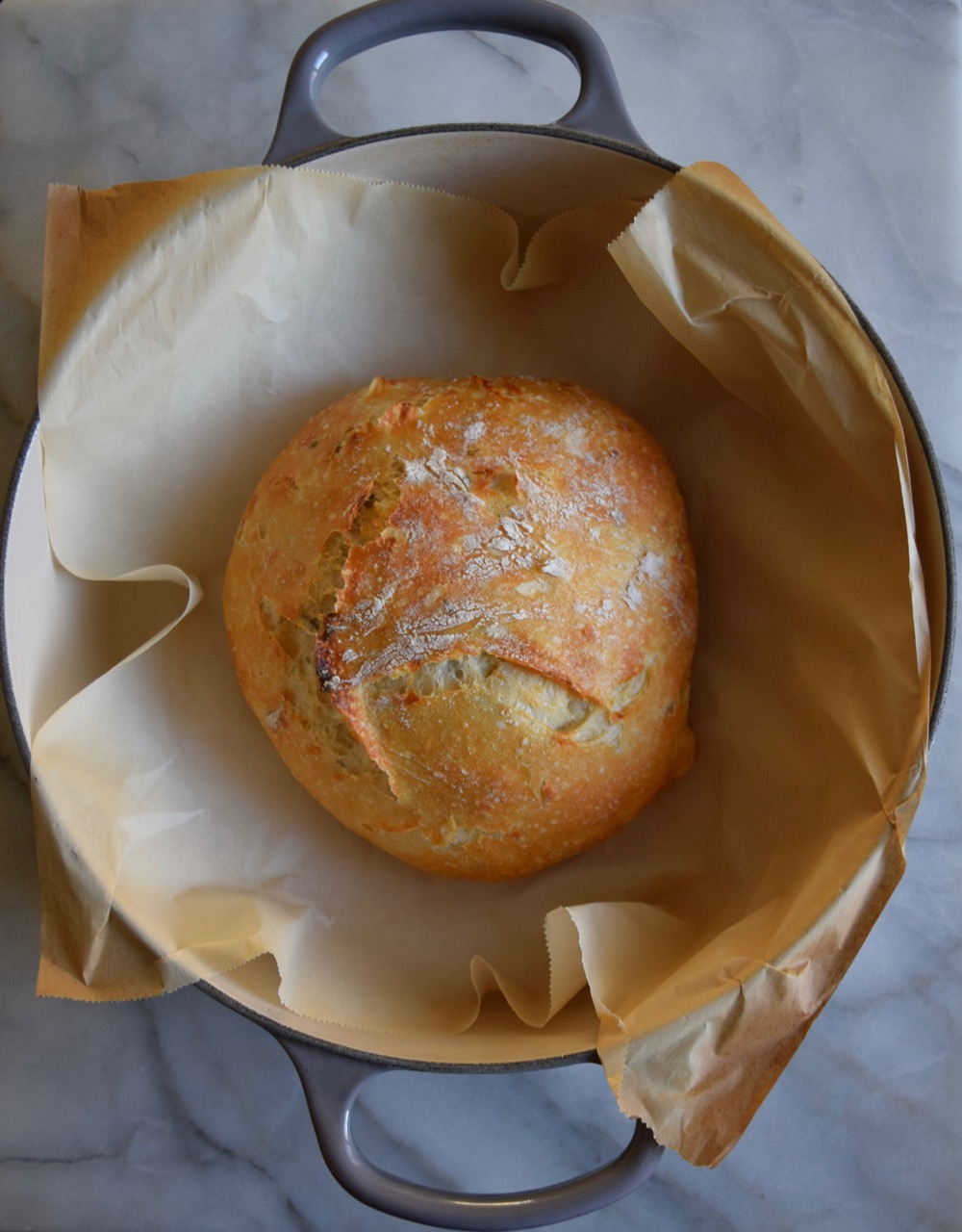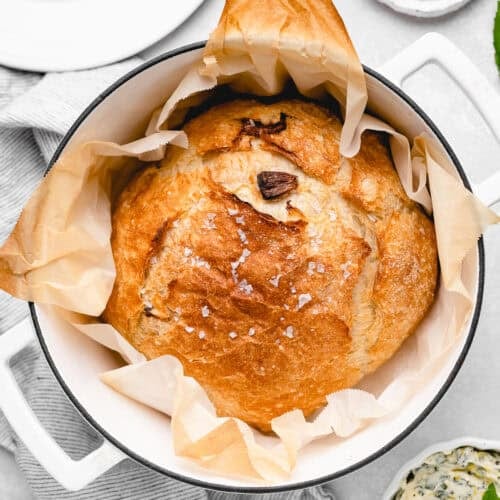Imagine biting into a warm, crusty loaf of bread that you made yourself—without any kneading or fancy tools. Sounds amazing, right?
With a Dutch oven and a simple no-knead recipe, you can create bakery-quality bread right in your own kitchen. You don’t need to be a baking expert or spend hours working the dough. This method lets you enjoy fresh, homemade bread with minimal effort.
Keep reading, and you’ll discover how easy it is to bake your perfect loaf using a Dutch oven—your new secret weapon for delicious bread.

Credit: glorifiedhobby.com
No-knead Bread Basics
No-knead bread is easy to make at home. It uses simple ingredients and takes little effort.
This bread is baked in a Dutch oven. The pot helps create a crispy crust and soft inside.
Simple Ingredients List
This bread recipe needs just a few basic ingredients. You can find them in most kitchens.
- Flour – usually all-purpose or bread flour
- Water – lukewarm to help yeast grow
- Salt – for flavor
- Yeast – active dry or instant yeast
How No-knead Works
No-knead bread does not need heavy mixing or kneading. It relies on time to develop gluten.
The dough rests for hours. This slow rise helps the bread get good texture and flavor.
- Mix ingredients until combined
- Let dough rest for 12 to 18 hours
- Shape dough gently without kneading
- Bake in a hot Dutch oven for crust

Credit: www.talesfromthekitchenshed.com
Choosing The Right Dutch Oven
Making bread in a Dutch oven is easy and fun. Choosing the right Dutch oven helps you bake better bread.
Different Dutch ovens have different features. These features affect how your bread will turn out.
Material And Size Options
Dutch ovens come in many materials like cast iron and ceramic. Each material holds heat differently.
Size matters because it affects how your dough fits. Pick a Dutch oven that fits your recipe size.
- Cast iron keeps heat well and lasts long
- Ceramic heats evenly but can be fragile
- Smaller sizes are good for small loaves
- Larger sizes work for big or multiple loaves
Why Dutch Oven Helps Bread
A Dutch oven traps steam inside while baking. This steam creates a soft crust and helps bread rise.
The heavy lid keeps heat steady. This heat makes the bread cook evenly and get a nice crust.
- Traps steam for a moist baking environment
- Keeps heat steady and even
- Creates a crispy crust
- Helps bread rise well
Step-by-step Baking Process
Baking bread in a Dutch oven without kneading is simple and fun. This method uses time to develop the dough’s texture and flavor.
The process includes mixing, rising, shaping, preheating, and baking. Follow these steps for a tasty loaf with a crispy crust.
Mixing And Initial Rise
Start by mixing flour, water, yeast, and salt in a large bowl. Stir until the ingredients form a sticky dough.
Cover the bowl with plastic wrap or a cloth. Let the dough rest at room temperature for 12 to 18 hours. This slow rise develops flavor and texture.
Shaping And Second Rise
After the first rise, turn the dough onto a floured surface. Shape it gently into a round ball without kneading.
Place the shaped dough on a piece of parchment paper. Cover it and let it rise again for 1 to 2 hours until it puffs up.
Preheating The Dutch Oven
About 30 minutes before baking, place your empty Dutch oven with the lid in the oven. Heat at 450°F (230°C).
Preheating helps the dough cook evenly and creates steam for a crispy crust. Be careful when handling the hot pot.
Baking Tips For Crispy Crust
Use parchment paper to transfer dough into the hot Dutch oven safely. Cover with the lid to trap steam.
- Bake covered for 30 minutes to create steam.
- Remove the lid and bake 10 to 15 minutes more for a golden crust.
- Let the bread cool on a rack before slicing.
Troubleshooting Common Issues
Baking bread in a Dutch oven without kneading is simple but can have some problems. Knowing how to fix these issues helps you get better bread.
This guide covers solutions for dense or gummy bread, crust problems, and uneven baking.
Dense Or Gummy Bread
Dense or gummy bread happens if the dough is too wet or undercooked. It can also occur when the yeast doesn’t work well.
Make sure you measure flour and water carefully. Let the dough rise until it doubles in size. Baking time might need to be longer.
- Use the right flour amount, not too much water
- Check if your yeast is fresh and active
- Let the dough rise fully before baking
- Bake until the inside is fully cooked
Crust Too Hard Or Soft
A crust that is too hard can burn or be uncomfortable to eat. A soft crust can mean not enough heat or moisture during baking.
Use high heat to get a good crust. Cover the Dutch oven during the first part of baking for steam. Remove the lid near the end for a crispy crust.
- Preheat the Dutch oven well before baking
- Keep the lid on for the first 20 minutes
- Remove the lid to brown and crisp the crust
- Adjust baking time to avoid burning or softness
Uneven Baking
Uneven baking makes some parts of the bread dry or doughy. It happens if heat is not spread well inside the Dutch oven.
Make sure your Dutch oven heats evenly. Use a heavy pot with a tight lid. Rotate the pot halfway if your oven has hot spots.
- Choose a thick, heavy Dutch oven
- Preheat the pot before adding dough
- Rotate the pot in the oven if needed
- Check oven temperature with a thermometer
Serving And Storing Tips
Bread made in a Dutch oven without kneading is easy to bake and tastes great. To enjoy it fully, you need to serve and store it properly.
This guide helps you serve your bread well and keep it fresh for longer.
Best Ways To Serve
Serve your Dutch oven no-knead bread fresh and warm. It tastes best right after baking. Slice it with a sharp knife to keep the crust crisp.
You can enjoy it plain or with butter, cheese, or jam. It also pairs well with soups and salads.
- Slice bread just before eating
- Warm slices slightly to soften the inside
- Use it for sandwiches or toast
- Serve with dips or spreads
Keeping Bread Fresh Longer
Store your bread properly to keep it fresh. Avoid wrapping it in plastic, which can make the crust soft and soggy.
Use a paper bag or cloth bread bag to keep the crust crisp. Keep the bread at room temperature and away from heat.
- Store in a paper or cloth bag
- Keep at room temperature, not in the fridge
- Freeze leftover bread for longer storage
- Slice before freezing for easy use

Credit: grandbaby-cakes.com
Variations To Try
Making bread in a Dutch oven without kneading is simple and fun. You can try different variations to create new flavors and textures.
These changes can make your bread more interesting and tasty. Here are some ideas to try next time you bake.
Adding Seeds And Nuts
Seeds and nuts add crunch and flavor to your bread. You can mix them into the dough before baking.
Try sunflower seeds, pumpkin seeds, walnuts, or almonds. They give the bread a nice texture and extra nutrients.
- Sunflower seeds for a mild, nutty taste
- Pumpkin seeds add a slight sweetness
- Walnuts give a rich, earthy flavor
- Almonds offer a crunchy bite
Using Whole Wheat Or Rye Flour
Try whole wheat or rye flour instead of white flour. These flours add a deeper taste and more fiber.
Whole wheat makes the bread denser and nuttier. Rye flour gives a slightly sour and earthy flavor.
- Use half whole wheat for a balanced texture
- Replace some flour with rye for a strong taste
- Adjust water as whole grains absorb more
Flavor Enhancements
You can add herbs, spices, or other ingredients to boost flavor. Mix them into the dough before baking.
Garlic, rosemary, or cinnamon can change the bread’s character. Use small amounts to keep the balance.
- Fresh rosemary for a herbal touch
- Minced garlic adds a savory note
- Cinnamon creates a warm, sweet flavor
- Olive oil adds richness and softness
Frequently Asked Questions
How Do You Bake Bread In A Dutch Oven?
Baking bread in a Dutch oven is simple. Preheat your oven with the Dutch oven inside. Once heated, place your dough inside, cover, and bake. The steam created inside ensures a crispy crust. Remove the lid halfway to brown the top.
Enjoy freshly baked, no-knead bread!
Why Use A Dutch Oven For No-knead Bread?
A Dutch oven is perfect for no-knead bread because it traps steam. The steam helps create a crusty exterior. It also maintains a consistent temperature, ensuring even baking. This makes your bread fluffy inside and crusty outside. It’s a foolproof method for perfect homemade bread.
Can I Use Any Dutch Oven For Baking?
Yes, any Dutch oven can be used for baking bread. Ensure it’s oven-safe up to high temperatures, usually around 450°F. It should have a tight-fitting lid to trap steam. Cast iron Dutch ovens are popular for their heat retention. Always check manufacturer guidelines for specific usage instructions.
How Long To Bake No-knead Bread In Dutch Oven?
Bake no-knead bread in a Dutch oven for about 30 minutes covered. Then, remove the lid and bake for an additional 15 minutes. This allows the crust to brown nicely. The total baking time is approximately 45 minutes. Adjust as needed based on your oven’s performance.
Conclusion
Baking bread in a Dutch oven without kneading saves time and effort. The crust turns golden and crisp, while the inside stays soft. This simple method suits beginners and busy cooks alike. You only need a few ingredients and patience to get great results.
Try this easy recipe to enjoy fresh, homemade bread anytime. No fancy tools or skills required. Just mix, wait, and bake. The smell and taste will make it worth it. Give it a go and see how simple baking can be.
